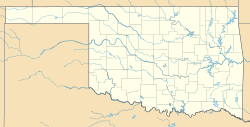James C. Nance Memorial Bridge facts for kids
Quick facts for kids James C. Nance Memorial Bridge |
|
|---|---|

US 77 James C. Nance Bridge, a deck truss 2-lane bridge built circa 1938 as seen from the Purcell train station prior to 2019 rebuild as 4 lane concrete pier bridge.
|
|
| Coordinates | 35°0′51″N 97°21′10″W / 35.01417°N 97.35278°W |
|
US Highway 77 James C. Nance Memorial Bridge at Canadian River
|
|
| Location | |
| Area | 3.5 acres (1.4 ha) |
| Built | 1938, rebuilt 2019 |
| Built by | Guy H. James |
| Architectural style | Deck Truss Bridge 1938; Concrete Pier Bridge 2019 |
| NRHP reference No. | 03000882 |
| Added to NRHP | September 2, 2003 |
| Carries | 2 lanes of |
| Crosses | Canadian River |
| Locale | Purcell-Lexington, Oklahoma |
| Maintained by | Oklahoma Department of Transportation |
| ID number | 06593 |
| Characteristics | |
| Design | Deck truss 1938; Concrete Pier 2019 |
| Total length | 1,110.1 metres (3,642 ft) |
| History | |
| Opened | 1938, rebuilt 2019 |
The James C. Nance Memorial Bridge is a very important bridge in Oklahoma. It connects the towns of Purcell and Lexington, Oklahoma by crossing the Canadian River. This bridge helps people travel easily between McClain County and Cleveland County. It carries two main roads: U.S. Route 77 (US-77) and Oklahoma State Highway 39 (SH-39). The bridge is named after James C. Nance, who was a local newspaper publisher and an important politician in Oklahoma.
Contents
About the Nance Bridge
The original James C. Nance Memorial Bridge was built around 1938. It was a "deck truss" bridge, meaning the road rested on top of a strong framework of metal triangles. This bridge had two lanes for cars. In 2019, a new, wider bridge was built in its place. The new bridge is a "concrete pier" design, which means it's supported by strong concrete columns. It now has four lanes for traffic.
Why the Bridge is Important
The Nance Bridge makes travel much faster between Purcell and Lexington. Without the bridge, a trip that normally takes only 3 minutes by car could take over an hour! This shows how vital the bridge is for daily life and business.
The bridge also has a nice walkway for people to use. From this walkway, you can see amazing views of the South Canadian River valley.
Connecting Communities
When the first bridge was built in 1938, it helped many towns connect. Communities on the west side of the river, like Purcell and Pauls Valley, could easily reach towns on the east side, such as Lexington. This connection helps trade and business flow smoothly in this part of Oklahoma. The new 2019 bridge keeps this important connection alive. It even has design parts, like concrete posts and wrought iron railings, that look similar to the original 1938 bridge.
Purcell's Water Supply
In 1982, the James C. Nance bridge was made stronger. A large pipeline was attached underneath it. This pipeline carried most of Purcell's water supply. The water comes from deep wells east of Lexington. Later, during the bridge's reconstruction, the pipeline was moved. It was bored (drilled) under the river instead of being attached to the bridge.
The New Bridge Opens in 2019
On July 26, 2019, the new US 77 Purcell/Lexington James C. Nance Bridge officially opened. This was a big celebration, just like when the first bridge opened over 80 years ago. The Oklahoma Department of Transportation (ODOT) managed this huge project.
The original 1938 bridge was the first state-owned bridge in this area. It replaced an older, privately owned toll bridge from 1911. That toll bridge had replaced an even older wooden bridge. So, the Nance Bridge continues a long history of connecting these communities.
Building the New Bridge (2017-2019)
The project to rebuild the bridge took two years, from 2017 to 2019. It was a massive undertaking!
- Workers used 20,000 cubic yards of concrete.
- They also used 6 million pounds of steel rebar.
- The new bridge is 3,726 feet long (about 1,136 meters).
- It took 325,000 hours of work to build.
- The total cost was $38 million.
The construction faced some challenges. Bad weather sometimes delayed work. Also, workers had to be careful of local wildlife living on or under the old bridge. Even with these challenges, the project finished five months earlier than planned!



